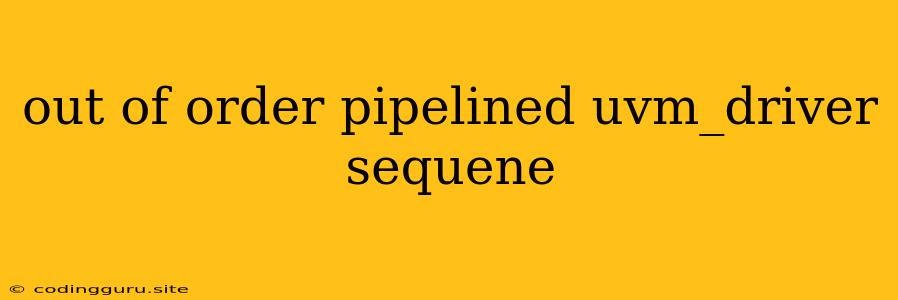Out of Order Pipelined UVM Driver: A Deep Dive into Sequential Verification
The world of verification is constantly evolving, with engineers seeking ways to test designs more effectively and efficiently. One common challenge is the verification of pipelined designs, where data flows through a series of stages, often out of order. This out-of-order execution can complicate verification, especially when utilizing the powerful Universal Verification Methodology (UVM).
So, how do we tackle the verification of out-of-order pipelined designs using UVM? The answer lies in the strategic use of sequences and drivers.
Understanding the Problem
Out-of-order execution introduces complexity because the order of data arriving at the output of a stage may not necessarily reflect the order in which it was originally sent. Traditional verification techniques may struggle to accurately track and verify the behavior of the design under these conditions.
Enter the UVM Driver and Sequence
The UVM provides a powerful framework for verification, enabling us to create reusable testbench components. Two key elements in this framework are the UVM Driver and the UVM Sequence. Let's break down their roles:
UVM Driver:
- Responsible for driving transactions to the DUT (Design Under Test).
- Handles the low-level communication with the DUT, ensuring the proper formatting and timing of transactions.
UVM Sequence:
- Defines the order and content of transactions to be driven by the UVM driver.
- Provides a higher level of abstraction, allowing us to focus on the test scenarios rather than the low-level communication details.
Out-of-Order Pipelined UVM Driver: Key Considerations
When dealing with out-of-order pipelined designs, our UVM driver and sequence must be carefully crafted to handle the following challenges:
-
Maintaining Order: While the DUT may process transactions out of order, we need to ensure the sequence itself maintains the intended order of transactions. This helps us track the correct flow of data and facilitates accurate verification.
-
Handling Dependencies: Transactions may have dependencies on each other, requiring specific execution order. The sequence must be designed to handle these dependencies, ensuring that transactions are driven in a way that satisfies the design requirements.
-
Verification Coverage: The sequence should be designed to cover all the relevant scenarios and corner cases of the out-of-order pipelined design, ensuring comprehensive verification.
Examples: Tailoring the Sequence for Out-of-Order Pipelined Designs
To illustrate these concepts, let's consider a simple example of a 2-stage pipelined design:
- Stage 1: Performs an arithmetic operation on the input data.
- Stage 2: Performs a logical operation on the output of Stage 1.
In this scenario, the DUT might process transactions from Stage 1 and Stage 2 out of order, meaning the output could arrive with a different sequence than the input.
Example Scenario:
- Transaction A: Input data = 5, Operation = Addition (Stage 1)
- Transaction B: Input data = 3, Operation = Multiplication (Stage 1)
- Transaction C: Input data = 10, Operation = AND (Stage 2)
- Transaction D: Input data = 2, Operation = OR (Stage 2)
Let's say the DUT outputs the results in the following order:
- Transaction B (Multiplication): Output = 15 (3 * 5)
- Transaction D (OR): Output = 12 (10 OR 2)
- Transaction A (Addition): Output = 10 (5 + 5)
- Transaction C (AND): Output = 0 (10 AND 2)
Even though the output order is different, we still need to verify the correctness of the operation based on the intended sequence of transactions:
- Transaction A: (5 + 5 = 10)
- Transaction B: (3 * 5 = 15)
- Transaction C: (10 AND 2 = 0)
- Transaction D: (10 OR 2 = 12)
Solution:
In this scenario, we can use the UVM Sequence to handle the out-of-order execution. The sequence can be designed to track the original order of transactions and ensure they are correctly verified, regardless of the order in which they arrive at the output.
Techniques for Managing Out-of-Order Execution
-
Transaction Tracking: The sequence can track the original order of transactions using a dedicated data structure, such as a queue or a list.
-
Dependency Management: The sequence can maintain a record of dependencies between transactions, ensuring that transactions are driven in the correct order based on their dependencies.
-
Synchronization Mechanisms: Techniques like wait-for and notify can be used within the sequence to synchronize the flow of transactions with the DUT's out-of-order execution behavior.
Conclusion
Verifying out-of-order pipelined designs using UVM requires a strategic approach, particularly with the use of sequences and drivers. By carefully designing these components to handle out-of-order execution and dependency management, we can effectively verify the behavior of complex pipelined designs, ensuring their functional correctness.
Remember, the key is to maintain a clear understanding of the design's operation and use the UVM's powerful features to create sequences that can accurately track and verify the flow of data, even in the face of out-of-order execution.
